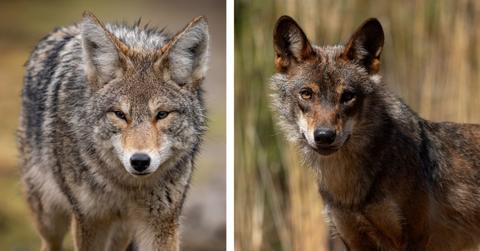DNA Testing Proves Whether Wild Dogs Were Wolves or Coyotes in Disguise
It's easy to understand how people can confuse the two, which is why scientists need to sometimes step in and verify the difference between coyotes and wolves.
Published May 15 2024, 3:10 p.m. ET

A case of mistaken identity can be a fun and fantastic plot point both on screen and on the page because of how much drama it can create. However, mistaken identity can have severe consequences when it comes to the animal kingdom. Confusing two animals could lead a whole team of scientists to open an investigation — like they did when "wolves" were suddenly spotted in an area they don't typically roam.
And while it's not too easy to mix up a tiger and a tiger shark, even the pros get it wrong with more similar species, like when it comes to coyotes and wolves. Keep reading to learn more, including about the wild goose chase a group of scientists went on when they thought they were hot on the trail of a trio of rare wolves in 2024.

DNA testing was used to confirm that Nevada wolves were actually coyotes.
A helicopter crew flying over a ranch in the rural Merritt Mountains of Nevada thought they were seeing a bit of history in the making when they saw what they thought was a trio of wolves cruising around, according to CBS News. Observers became excited because the last confirmed wolf sighting took place in 2017, which marked the first time a wolf was documented in Nevada in nearly a century.
Of course, everyone was excited by this potential new find, and the local wildlife department conducted its own surveys to collect information about the small pack. After collecting urine, fecal, and hair samples that officials believed belonged to the wolf pack, they conducted a DNA analysis at two different laboratories to determine what they were dealing with.
That may seem like a big fuss for such a small group of would-be wolves, but ABC News reports that the experts were keen on getting a definitive answer on the DNA of the dogs because they were trying to figure out why so many moose had been crossing state lines. Nevada had seen an influx of horned visitors since 2018, and they thought wolves on the hunt could be to blame for the situation.
Unfortunately for local wolf enthusiasts, the canines in question turned out to be coyotes, a wild animal that remains fairly common in the desert state. In fact, according to the Sierra Nevada Ally, there are an estimated 55,000 to 110,000 coyotes (which breaks down to .5 to 1 coyote per square mile) within state lines!
Coyote vs. wolf: the difference between these two animals.
If you don't have access to an independent lab to conduct a rigorous investigation, you can arm yourself with these basic facts to help you tell the difference between a coyote and a wolf. First, wolves are known to be larger than coyotes and have smaller ears and blockier heads, according to Outdoor Life magazine. Not only that but their legs and paws are larger as well.
While adult wolves are undeniably larger than coyotes, size isn't the only difference. You may be able to tell the difference between them based on coloring alone since wolves can be reddish, black, white, or buff colored, while coyote fur doesn't vary too much and tends to be between tan and black. And, of course, there's their diets as well. While wolves are known for hunting down their prey, coyotes tend to be more scavengers than anything else.
That said, you wouldn't want to wait until feeding time to determine whether you're up against a wolf or a coyote. Fortunately, with all these details it should be easy enough to tell before you get that close!